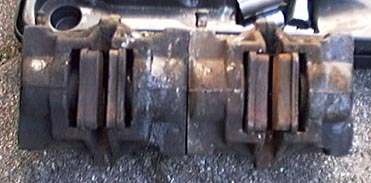With bigger front brakes in place, it was time to start thinking about the back. The stock load dependent rear brakes have a reputation of not doing much anyway (although having an LPG tank in the back helps a lot!), so it seemed worthwhile to correct the f/r brake balance and dial out a very slight nose dive. With its trailing arm rear suspension, that pulls the rear down upon braking, a BX should not dive at all.
My 283mm Xantia VSX front brakes are about 25% stronger than stock BX front brakes. So I would have to add about the same amount in the rear, to even things out. Don't want to overdo it though, as front bias is much safer than rear! On the other hand, best stopping distance can only be achieved when using all four contact patches to the max.
Xantia front brakes were so easy to fit that I looked in the same direction for the rears. I looked up some measurements in a catalog. As you can see below there's little difference, apart from a 21 percent bigger piston area. Perfect! Xantia wagon rear brakes are even bigger, but that would be too much, if it fits at all. And how about this... it looks like worn out Xantia discs could start a second life as BX discs!
| Car | Piston | Disc diameter | Disc thickness | Wear limit |
|---|---|---|---|---|
| BX (all) | 30 | 224 | 7 | 5 |
| Xantia | 33 | 224 | 9 | 7 |
| Xantia wagon | 36 | 251 | 12 | 10.8 |
At the local junkyard, I pulled a caliper off a Xantia, walked to the other side and bolted it onto a BX. A perfect fit... sold!
Spot the differences - BX vs. Xantia:

The difference is minimal. Only the pistons are bigger (yes, they really are) but other than that... it even appears to be the same casting. One detail is the bolts come greased on a BX, but not on a Xantia. Who cares? Well, saving this 0.1 cent at the factory does cause most Xantia bolts to seize in a mess of rust and corrosion, some even breaking off. The bolts on a BX however, are usually easy as pie, even though they are older! You know what to do, when putting things together.
As expected, putting Xantia rear brakes on was very easy, although I had to replace one wrecked line seal. Because I left the thinner BX discs on, I may have to replace the brake pads slightly sooner in the future, to prevent them or the caliper pistons from coming loose.
When bleeding the rear brakes, pay attention that the car is absolutely horizontal, or with the side being bled up. If the other side is higher, you won't get all the air out as the bleeder has to be the highest point of the caliper.
After careful break-in, I can say the car definitely lost its slight nose dive. Braking is perfectly flat now. If you try really hard, stepping on the brake during hard cornering, you can make the rear feel very slightly "loose", but it stays on track. Excessive rear brakes can be dangerous and make it swap ends, but these don't. But you can feel they are there - unlike you can with stock BX rear brakes. Overall I think it is very well balanced now. It still locks up the fronts first, but only by a small margin. This translates to a (roughly measured) stopping distance many newer cars could envy.
